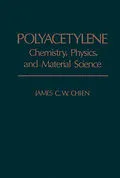Polyacetylene: Chemistry, Physics, and Material Science reviews the chemistry, physics, and material science of polyacetylene. Topics covered include polymerization and crystal structure of polyacetylene, isomerization, neutral defects, and solitons. Globular morphology and the effect of heat of polymerization on polyacetylene are also discussed, along with doping and chemical reactions of polyacetylene.
This book is comprised of 12 chapters and begins with an introduction to a few basic principles of polymer chemistry and solid-state physics, followed by an overview of charge-transfer salts and conducting polymers other than polyacetylene and a historical background on polyacetylene and a general description of its properties. The next chapter gives a detailed treatment of polymerization, with particular reference to the mechanisms and kinetics of acetylene polymerization and direct determination of polyacetylene molecular weight by radioquenching. The remaining chapters focus on the crystal structures and morphology of undoped polyacetylenes; methods of isomerization; spectroscopic, physical, and mechanical properties of undoped polyacetylene; and various chemical reactions of polyacetylene and polymethylacetylene. The probable mechanisms of doping are proposed and theoretical models for polyacetylene are presented. The final chapter considers a few technical applications of polyacetylene.
This monograph will be of interest to chemists, physicists, and polymer scientists and engineers.
Inhalt
Preface
Chapter 1 Introduction
1.1 Synthetic Polymers
1.2 Energy Bands
1.3 Metals, Semiconductors, and Insulators
1.4 Semimetals: Dimensionality
1.5 Charge-Transfer Salts
1.6 Organic Conductive Polymers
1.7 Polyacetylene
Chapter 2 Polymerization
2.1 Introduction
2.2 Polymerization of Acetylene Catalyzed by Ti(OBu)4-AlEt3
2.3 Polymerization of Acetylene by the Luttinger Catalyst
2.4 Methylacetylene Homo- and Copolymers
2.5 Polymerization Mechanism
2.6 Molecular Weight Determination
2.7 Kinetics
2.8 Comparison of Various Catalyst Systems
2.9 Graft and Block Copolymers
Chapter 3 Structures
3.1 Introduction
3.2 Geometric Isomerism
3.3 Chain Regularity
3.4 Degree of Crystallinity
3.5 Crystal Structure of cis-Polyacetylene
3.6 Crystal Structure of trans-Polyacetylene
3.7 Bond-Length Alternation
3.8 Thermal Isomerization and Crystal Structure Change
3.9 Crystal Structure of Diblock Copolymers of Styrene and Acetylene
Chapter 4 Morphology
4.1 Introduction
4.2 Fibrils and Microfibrils
4.3 Globular Morphology and Effect of Heat of Polymerization
4.4 Lamellar Morphology
4.5 Whiskerlike Ribbon Crystal Morphologies
4.6 Mechanically Aligned Polyacetylenes
4.7 Surface Areas
Chapter 5 Isomerization, Neutral Defects, and Solitons
5.1 Introduction
5.2 Thermal Isomerization
5.3 Doping-Induced Isomerization
5.4 Electron Paramagnetic Resonance and Neutral Defects
5.5 Spin Dynamics
5.6 Mechanisms of Soliton Formation and of Cis-Trans Isomerization
Chapter 6 Spectroscopic, Physical, and Mechanical Properties
6.1 Vibrational Spectra
6.2 Optical Absorption and Reflections
6.3 Photoexcitation, Luminescence, and Photoconductivity
6.4 Heat Capacity
6.5 Thermal Conductivity
6.6 Tensile Properties
6.7 Dielectric Constants
6.8 Proton Nuclear Magnetic Resonance
6.9 Carbon-13 Nuclear Magnetic Resonance
Chapter 7 Chemical Reactions
7.1 Thermochemistry
7.2 Reactions with Hydrogen
7.3 Reaction with Bromine
7.4 Reaction with Ozone
7.5 Reaction with Oxygen
7.6 Cross-linking
Chapter 8 Doping
8.1 Introduction
8.2 Doping Methods
8.3 Dopants and the Nature of Dopant Species
8.4 Doping of cis- and trans-Polyacetylenes
8.5 Diffusion of Dopants
8.6 Compensation
8.7 Effect of Doping on Morphology
8.8 Mechanisms of Doping
Chapter 9 Conducting Polyacetylene
9.1 Introduction
9.2 Crystal Structure
9.3 Magnetic Susceptibilities
9.4 Visible and Infrared Absorptions
9.5 Nuclear Magnetic Resonance
9.6 Specific Heats
9.7 Photoelectron Spectra
9.8 Stability
Chapter 10 Theoretical Models
10.1 Band Structure
10.2 Microscopic Discrete Model for a Neutral Soliton
10.3 Continuum Model
10.4 Coulombic Interaction and Correlation Effect
10.5 Properties of Solitons
10.6 Polaron
Chapter 11 Electrical Properties
11.1 Mechanisms for Transport
11.2 Thermopower
11.3 Electrical Conductivity
11.4 Spectroscopic Conductivity
11.5 Microwave Conductivity
11.6 Homogeneity of Doped Polyacetylene
11.7 Probable Transport Mechanisms
Chapter 12 Technology
12.1 Rechargeable Batteries
12.2 Semiconductor Devices and Properties
12.3 Solar Cells
References
Index
